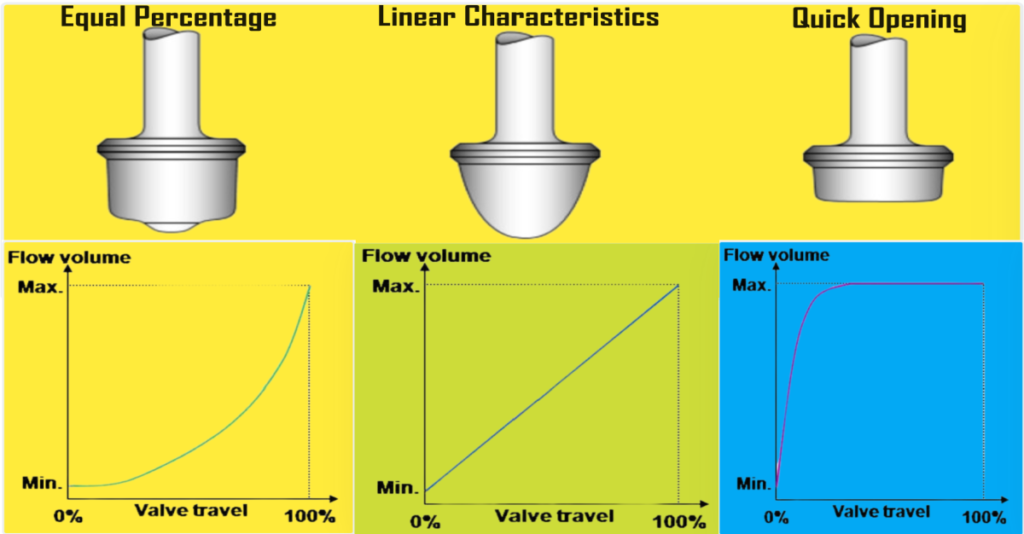Control valves are used in regulating fluid flow and pressure in various industrial processes. One of the key components of control valves is the valve plug, which determines how effectively the valve can control the flow of fluid. Understanding valve plug contours and flow characteristics of control valves is essential for optimizing valve performance and ensuring efficient operation in industrial settings.
What Are Valve Plug Contours?
Valve plug contours refer to the shape of the part of a control valve that controls the flow of fluid. These contours can vary significantly depending on the specific requirements of the application and the characteristics of the fluid being controlled. The shape of the valve plug directly influences how smoothly the fluid flows through the valve and how precisely it can be controlled.
Types of Flow Characteristics & Valve Plug Contours.
Linear, equal percentage, and quick opening, refer to the inherent flow characteristics of control valves. These characteristics dictate how the valve responds to changes in the input signal (such as the valve position) and how it modulates the flow rate of the fluid. Below picture shows the control valve flow characteristics and valve plug contours with characteristics curves.

Here’s a brief explanation of each of these flow characteristics:
1. Linear Flow Characteristic:
In a linear flow characteristic, the valve’s flow rate changes linearly with the change in valve position. This means that if the valve is opened 20% from the closed position, the flow rate will increase by 20%. Linear valves are suitable for applications where a direct relationship between the control signal and flow rate is required, such as in simple level control systems.
2. Equal Percentage Flow Characteristic:
In an equal percentage flow characteristic, the percentage change in flow rate is constant for each percentage change in valve position. As the valve opens, the flow rate increases exponentially, making it suitable for applications requiring fine control at lower valve positions and quick response at higher positions. Equal percentage valves are commonly used in processes where precise control over a wide range of flow rates is needed, such as temperature and pressure control.
3. Quick Opening Flow Characteristic:
In a quick opening flow characteristic, the valve initially opens rapidly, allowing a large flow rate at lower valve positions. This characteristic is useful when a quick response is needed at the beginning of the control range. Quick opening valves are often used for on-off applications, such as emergency shutdowns or safety relief systems.
4. Modified Contours:
In addition to these standard contours, modified valve plug contours can be customized to meet specific application requirements. These may include parabolic, logarithmic, or custom-designed shapes tailored to achieve precise control under unique operating conditions.
These flow characteristics influence how the valve interacts with the process and how it adjusts the flow rate in response to changes. The choice of flow characteristic depends on the specific requirements of the control application. Some control valves also offer adjustable characteristics, allowing engineers to fine-tune the valve’s response to meet the desired control strategy.
Factors Influencing Selection.
When selecting the appropriate valve plug contour for a particular application, several factors must be considered:
- Fluid Characteristics: The type of fluid being controlled, including its viscosity, density, and temperature, can influence the optimal contour choice.
- Flow Requirements: The desired flow rate and the range of flow conditions expected during operation will impact the selection of the valve plug contour.
- System Dynamics: The dynamic response characteristics of the control system, including stability and response time, must be taken into account to ensure effective control.
Valve plug contours are a critical aspect of control valve design, directly impacting the performance and efficiency of industrial processes. By understanding the different types of valve plug contours and their respective applications, engineers can select the most suitable option to achieve precise and reliable fluid control. With careful consideration of factors such as fluid characteristics, flow requirements, and system dynamics, control valves can be optimized to meet the unique needs of each application, ensuring smooth operation and optimal performance.
General Frequently Asked Questions.
What are meant by Inherent Control Valve Flow Characteristics?
How to select right flow characteristics of control valve?
Process Requirements: The specific requirements of the process, such as desired flow rates, pressure drop limitations, and response times, will influence the selection of flow characteristics.
Fluid Properties: The properties of the fluid being controlled, including viscosity, density, and compressibility, can affect the behavior of the valve and may warrant the selection of particular flow characteristics.
System Dynamics: Consideration of the overall system dynamics, including stability, transient response, and interaction with other control elements, is essential for ensuring optimal valve performance.
What are Types of Inherent Flow Characteristics?
Linear: In a linear flow characteristic, the change in flow rate is directly proportional to the change in valve position. This means that equal increments in valve opening result in equal increments in flow rate. Linear characteristics are ideal for applications requiring precise and consistent control across the entire operating range.
Equal Percentage: In contrast to linear characteristics, equal percentage flow characteristics result in a nonlinear relationship between valve position and flow rate. Small changes in valve opening produce larger changes in flow rate at low valve positions and smaller changes at high positions. This characteristic is often preferred for applications where precise control is needed over a wide range of flow rates.
Quick Opening: Quick opening flow characteristics feature a steep initial increase in flow rate with minimal valve movement, followed by a more gradual change. These characteristics are beneficial for applications requiring rapid response times or for valves used in on/off control applications.